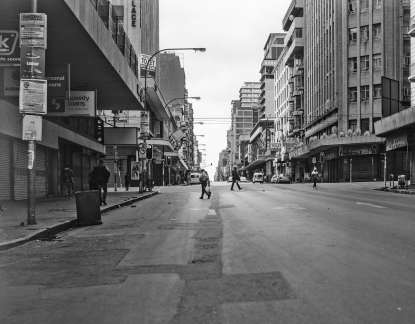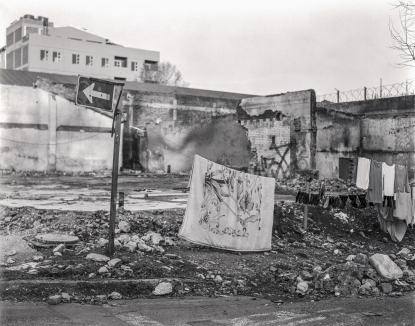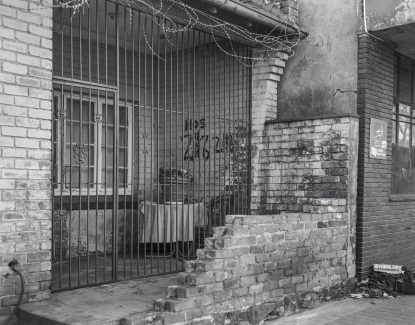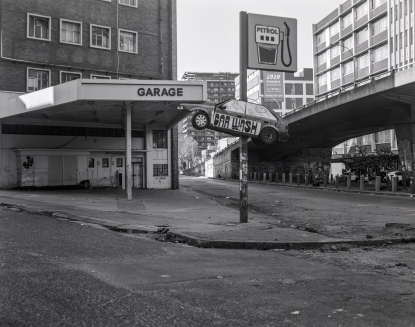Johannesburg, muted
Marco Longari, AFP's head of photography in Africa, has lived in Johannesburg since 2014. Marco started out as a photographer in his native Rome. He then went to Kosovo as a freelancer in 1998, an assignment that resulted in his first book "Neighbours at War". Two years later, his story with Africa began, when he became AFP's stringer in Rwanda. He went on to become the agency's chief photographer in Nairobi and Jerusalem. His work during the Arab Spring prompted Time magazine to name him Best Photographer on the Wires in 2012.
When the COVID-19 lockdown began in South Africa on March 27, he decided to tell the story in a different way. Instead of using a digital camera with which he usually works, he decided to go back in time. He bought a LinhofTechnika III, a large format camera that first came on the market in 1946. It required him to move slower, which somehow fit right in with the quietness of the city.
Marco could only find two boxes of black and white film. The images he produced captured the spirit of the city, devoid of its habitual hustle and bustle... it was if the city had lost its color. A narrative to read and hear.
Johannesburg is not everyone's ideal city. It is large, it is loud; it is vibrant and at times it is dangerous. Six million people in an area that sprawls from district to district and has all of the usual city problems of pollution and traffic and crime. There are limits on what you do and where you go. You can never lower your guard but it isn't all fear and insecurity. There are places where you can take a leisurely stroll and others where you cannot but that is the same in Paris, or Rome, or New York or London. But there is a spirit to this city. You find real people, who work and, occasionally, fight. Nowhere more so than me neighbourhood of Hillbrow where each journey to the local shop is strewn with possibilities, some good, some bad, all of them adventures of some sort.
When the lockdown came, it was as if someone had cut the sound. It was as if we had gone from a colour film with a soundtrack and sounds that bring the screen alive to a silent movie, flickering in black and white. The noise was replaced by silence, the bustle reduced to calm. I wanted to capture that sense of lockdown tranquility.
The city found itself muted and it had become "a new canvas where new stories had to be told"
This was not a project for a digital camera. It needed the greater depth and definition of film. At the back of my mind was some of the astonishing work that David Goldblatt produced during the aparthied years in South Africa. I wanted to take advantage of the calm which had seized the city and which allowed concentration and precision. It needed the Lienhof. This is an old folding view camera, a throwback to the early days of photography. You work blind when loading the film with your hands inside a sleeve, you disappear under a cloth to take the photo. As there is no mirror, the image you see through the lens is upside down. The focus has to be absolutely right, the light, everything has to be calibrated before you take the picture. It is a very different process to the daily job of a photographer journalist at Agence France-Presse.
 Hillbrow district, Johannesburg, April 15, 2020 (AFP/ Marco Longari)
Hillbrow district, Johannesburg, April 15, 2020 (AFP/ Marco Longari)
Hillbrow is one of the oldest parts of Johannesburg, dating back to the 1880s. It has changed a bit since then although there is still a great sweeping view from the brow of the mountain ridge that crosses the city. You look towards the city centre and you get a perspective of a large empty boulevard and the buildings at the back. I set up in the middle of the street and put my head under the cloth to take the shot. I was locked off in my own upside down world, relishing the silence. It was a moment of blessing, a rare opportunity. Only when I came out from under the cloth did I realise I had gathered an audience. There were around 20 people at the windows of the building behind me. This happened a few times, people were moving around me delicately, as if they understood the spirit of what I was doing.
 Johannesburg, April 15, 2020, Lilian Ngoyi street (AFP / Marco Longari)
Johannesburg, April 15, 2020, Lilian Ngoyi street (AFP / Marco Longari) Johannesburg, April 15, 2020, Rissik street, near the Central station
Johannesburg, April 15, 2020, Rissik street, near the Central station
 Johannesburg, May 7, 2020, view of the skyscrapers of Braamfontein and Hillbrow from the large Bree street bus terminal (AFP/ Marco Longari)
Johannesburg, May 7, 2020, view of the skyscrapers of Braamfontein and Hillbrow from the large Bree street bus terminal (AFP/ Marco Longari)This image is taken from the second floor of a large bus terminal, normally crowded with people. It is one of the big meeting places for the locals. In the background, we can see a fairly modern district of the city centre which, when I took the picture, was empty and silent. Very strange.
 Johannesburg, May 9, 2020, in the district of Jeppestown (AFP/ Marco Longari)
Johannesburg, May 9, 2020, in the district of Jeppestown (AFP/ Marco Longari)
 Kensington district, Johannesburg on May 9, 2020 (AFP / Marco Longari)
Kensington district, Johannesburg on May 9, 2020 (AFP / Marco Longari)
 Kensington district, Johannesburg, May 9, 2020 (AFP/ Marco Longari)
Kensington district, Johannesburg, May 9, 2020 (AFP/ Marco Longari)
 Johannesburg, May 9, 2020. Don Buildings on Commissioner street. (AFP/ Marco Longari)
Johannesburg, May 9, 2020. Don Buildings on Commissioner street. (AFP/ Marco Longari)Taking the pictures is only one part of the process. The other is developing. These days there is only one person who develops black and white in Johannesburg, Dennis da Silva. He is a specialist and a legend in his own right. Anyone who is anyone in South African photography over recent years has gone through Dennis. The Bang-Bang Club guys, Goldblatt, they all went to Dennis. He was working on some large prints from Ernest Cole at the time which were astounding.
 Johannesburg, April 15, 2020. "Belvista Flats", in the "Central business district". (AFP/ Marco Longari)
Johannesburg, April 15, 2020. "Belvista Flats", in the "Central business district". (AFP/ Marco Longari)Unfortunately, he didn't want to know me when I called. He was confined to his home and concerned about contracting coronavirus. I rang him day after day until he gave in. He opened his lab for me and took my first set of shots. He wasn't too impressed though. He calls me and tells me 'Marco, what did you do?'
I made my excuses about it being my first time and fumbling around trying to load the film within the black sack, I must have got something slightly wrong with the alignments, misloaded the film perhaps. It's not easy in the dark when it is all touch and feel. Some of the shots were unusable. I promised to do better with the second set which, thankfully I did, so Dennis was pretty happy. In the end I was able to pick out 16 frames from 40.
 Johannesburg, May 10, 2020, petrol station on Davies Street in Doornfontein (AFP / Marco Longari)
Johannesburg, May 10, 2020, petrol station on Davies Street in Doornfontein (AFP / Marco Longari)
It will be a long time before life in Johannesburg gets anywhere near back to normal. We have not yet reached the peak of the epidemic. In some ways, as people who chronicle events as they unfold and record the history, we are fortunate to witness an event of this scope and intensity. But that also brings with it a huge sense of responsibility.
Every day we bring back photos that add a brick to this unfolding story which is touching everyone across the planet. We have to bring images that have a meaning, an identity, a story that speaks to people. There was a stage when I felt caught in the whirlwind of history, soemthing that is inevitable when you work for an agency the size of AFP. But this project gave me the chance to find a moment to stop, think, focus and find another point of view. We all need that from time to time. It helps us make sense of the history unfurling around us.
 Johannesburg, May 10, 2020, the paths of Parkhurst are strewn with leaves that gardeners can no longer pick up (AFP / Marco Longari)
Johannesburg, May 10, 2020, the paths of Parkhurst are strewn with leaves that gardeners can no longer pick up (AFP / Marco Longari)
This blog was written and recorded with Michaela Cancela-Kieffer in Paris



